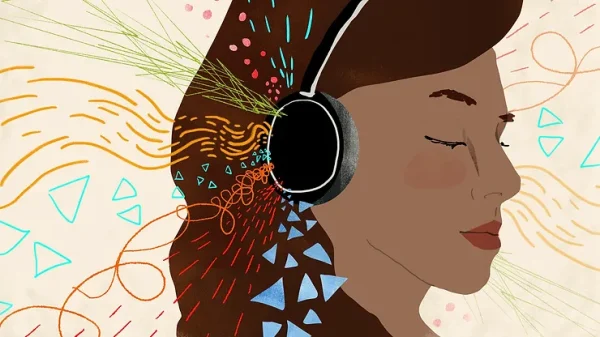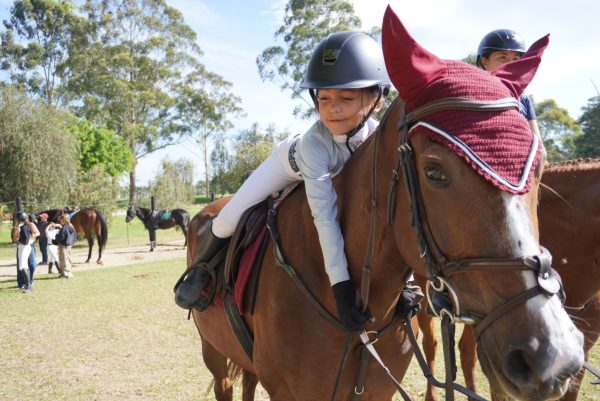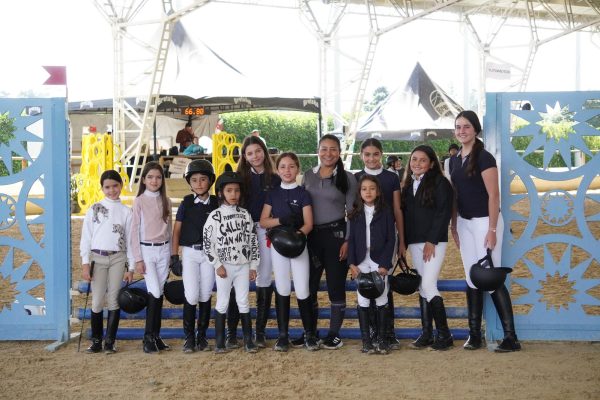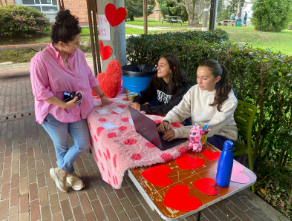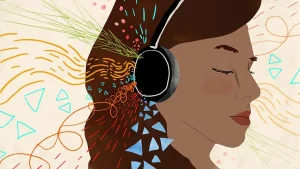The influence of music on students’ learning experiences has been a topic of debate among educators. While some teachers view music as a significant distraction, others argue that it can enhance the learning process.
Imagine a world without music—a place lacking rhythms that evoke strong feelings in us, tones that move our bodies, and melodies that speak to our souls. Fortunately, our reality is far from this stark scenario. Music, an enchanting and universally recognized art form, occupies a significant place in the lives of individuals, contributing significantly to their sense of self and overall well-being. However, music is often frowned upon in the classroom, as individuals consider that such harmonies can be distracting and disruptive. On the other hand, other people view music as an inspirational source, with the power to release students’ energy and channel it into a productive task, such as learning.
“In my class, students often ask me if they can listen to music, and in my experience, it can be quite effective. It’s all about finding a balance between the music I personally enjoy and the tunes that enhance my focus. While I love listening to rock, I do acknowledge that overly intense music can sometimes promote distraction,” John Higuita, Grade 9 technology teacher
Research suggests that music can impact various systems, including sensory, attentional, cognitive, emotional, and motor capacities, all of which play pivotal roles in the overall learning process (Konrad, R.R., Empathy, Arts, and Social Studies). For instance, a recent survey conducted by OnePoll on behalf of the online university CSU Global delved into the relationship between music and studying. The findings revealed that students who incorporated music into their study routines were more likely to achieve a GPA above 3.2.
“Approximately half of the 2,000 respondents reported regularly listening to music while studying (49%), and a substantial majority (60%) indicated that they performed better academically with background music compared to studying in complete silence. These findings provide insights into the subtle ways in which music can impact students’ learning experiences, sparking a valuable conversation within the realm of education,” OnePoll said.
In the pursuit of academic excellence, students often turn to a variety of study strategies, from meticulously organized notes to timed study sessions. However, for some, the path to success takes a more unconventional twist—one that involves music as a trusted ally.
“I find it easier to study with music, and it aids my academic performance because my brain operates in a manner where I consistently require some level of distraction in the form of background noise to achieve full concentration on my tasks. It might seem unconventional, but it’s a necessity for me,” Mariana Tavera, a grade 11 student, said.
The intersection of music and education offers a fascinating perspective, and Higuita’s perception underscores the profound influence of music on creative disciplines like graphic design. He emphasizes the importance that music has in educational techniques, working as a relatable resource to engage students.
“Yes, in my career as a graphic designer, music’s influence on graphic design is enormous. Some bands, for example, incorporate graphic design concepts and play with elements like colors and design. These are concepts that teachers currently use as references in their classes to show essential knowledge and inspire graphic designers through music,” Higuita said.
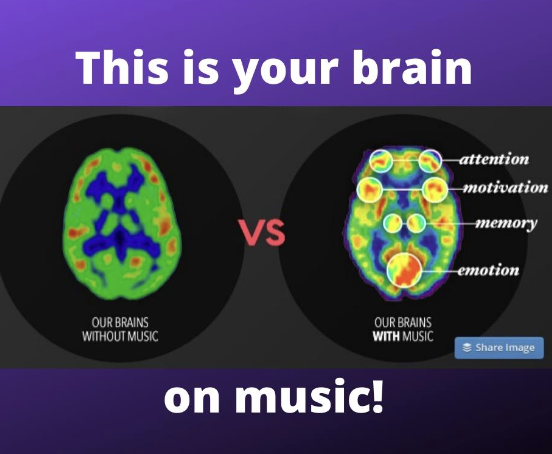
Image by Muzology @facebook.com
Moreover, as contemporary music continues to exert its influence, there is a growing concern about the potential impact of song lyrics on adolescents. Given that many young people tend to idolize music artists, it underscores the vital importance of setting a positive example.
“Being in the public eye, especially for artists, carries a profound responsibility. What we bring to the forefront of society matters immensely, as it shapes the perceptions and aspirations of those who look up to us, particularly the young generation. It is imperative that the message we convey through our art and actions is one of positivity and inspiration,” JROSS, a gospel artist and music producer, said.
This resonates with the broader discourse on the ethical responsibility of artists in today’s media’s evolving world, where their actions and lyrics hold a powerful influence over developing minds.
Following, this profound connection between music artists and their fans highlights the powerful role that musicians play in shaping not only the entertainment landscape but also the lives of their devoted followers. While the impact of music on individuals’ lives is well-documented, it’s equally important to acknowledge the reciprocal relationship that often forms between fans and their favorite artists. For many, artists like One Direction are more than just performers—they become role models, influencers, and a source of inspiration that extends beyond their music.
“Most of all, the artist that I’ve liked since I was little, for example, One Direction, I feel they have an influence on what I do because more than just listening to their singing, I also like to follow their daily life, follow what they try to make the public do, and be the kind of person they want their fans to be,” Tavera said.
With this in mind, the Oxford English Dictionary defines music as “That one of the fine arts which is concerned with the combination of sounds with a view to beauty of form and the expression of emotion…” (1989, p. 126). Therefore, it is evident that common wisdom has long recognized music as primarily an emotional journey. The study of the psychology of music contributes significantly to our comprehension of emotions, ultimately enhancing emotional intelligence, fostering creativity, and offering therapeutic benefits.
However, it’s worth noting that many individuals express concerns about certain song lyrics that they believe promote negative values, often tackling subjects like drugs, sex, and violence. A study published in the Journal of Personality and Social Psychology sheds light on the potential consequences of such lyrics. It suggests that violent song lyrics have the capacity to amplify negative emotions and thoughts, potentially contributing to aggressive behavior. This contradicts the generally accepted notion of emotional release, which holds that expressing negative emotions through music helps lessen aggressive inclinations. Instead, the study implies that it may intensify aggressive thoughts and feelings, with possible implications for long-term perceptions of society and personal development.
Without a doubt, the intricate relationship between music and human behavior is a subject of considerable interest, and Higuita’s perspective opens the door to a deeper exploration of the dual impact that music can have on our actions and attitudes.
“I truly believe that music can have both a positive and negative influence on people’s behavior. If you’re listening to reggaeton, it’s harder to concentrate due to the lyrics,” Higuita said.
The debate over the impact of negative language in music on individuals’ behavior and daily lives is a complex one, and Mariana’s perspective sheds light on the nuanced relationship between lyrical content and personal actions.
In a world where music often blurs the lines between art and reality, questions about the influence of negative language in songs on our everyday behavior have become increasingly relevant.
“I don’t think that music has a negative influence in my life because there are some songs that say bad words that, even though I sing them and yell them, it doesn’t mean that I’m doing that daily. However, there are some songs that I only like due to the fact that they relate to my everyday life, but it doesn’t mean that because the song says it, I’m going to do it,” Tavera said.
While the impact of music is undeniable, research indicates that it triggers emotions in approximately 55% to 65% of all listening experiences (Juslin et al., 2008; Juslin & Laukka, 2004), underscoring the inevitability of elicited feelings. Addressing negative lyrics in songs is undoubtedly a complex and sensitive matter, demanding responsibility and mindfulness from artists and songwriters regarding the potential influence on their audience. Nevertheless, it is essential to recognize that discussions and reflections on these topics should begin within the confines of each teenager’s household, allowing for the establishment of boundaries between artistic expression and reality. This approach fosters a healthier relationship between young listeners and song lyrics. In spite of that, it is crucial to remember that music is not solely a source of negative influence. Positive song lyrics also possess the power to inspire and motivate teenagers, contributing positively to their emotional and cognitive development.
“I had two students dancing there in the middle of the room, and I was standing there, thinking, ‘Okay, you’re happy, but what about what we are doing right now? That’s why I truly believe that if you’re going to listen to music while you’re working, it has to be something that helps you focus on what you’re doing and energizes you while simultaneously channeling the information for good results,” Higuita said.
“Yes, normally I feel that if I’m going through a sad moment and I listen to a sad song, it helps me to release some of my stress. Also, if I’m sad, sometimes listening to a happy song or a really up-tone song helps me get back up,” Tavera said.
In brief, In the world of music, feelings are powerful. It provides comfort, a connection to experiences, and a universal language. Music’s impact on learning sparks debate, yet evidence points to cognitive advantages. However, there continue to be worries regarding song lyrics and their impact on teenagers, highlighting the importance of artists serving as positive role models. Even though emotions are connected to music, it’s critical to address possible harmful lyrics. To navigate this complexity and maintain music’s influence as a strong, uplifting force in our lives, open communication and reflection are crucial. Undoubtedly, the influence of music on youth culture is undeniable, and it serves as an enduring form of artistic expression that educates and assists teenagers in various ways.


